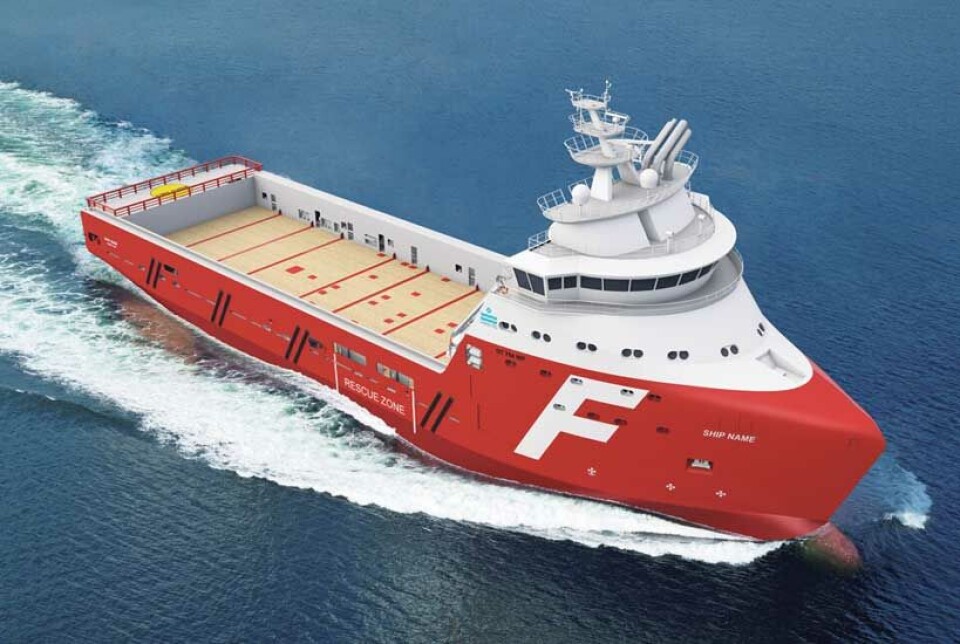
«Far Solitaire» – new innovative chemical tanker compliant PSV
The innovative chemical tanker compliant Platform Supply Vessel, «Far Solitaire», is delivered to Farstad Shipping in October 2012. The technologically advanced vessel is developed by Farstad in close cooperation with Rolls Royce Marine and is the first vessel of its kind ever built.
Denne artikkelen er tre år eller eldre.
The offshore oil industry has over the years become more and more dependent on chemicals and noxious liquids in order to improve operational efficiency and maintain safety standards. At the same time, restrictions for offshore disposal of the same have become more stringent for environmental reasons.
In the next turn these liquids need to be transported to- and from the offshore installations, which means need of capable Platform Supply Vessels fit for this purpose. However, a conventional Offshore Supply Vessel defined by the rules as a Cargo Vessel is limited to carry maximum 800 cubic meters of these liquids on board at a time, which often is insufficient for the Operator and do not utilise the vessels over all capacity.
The steel hull recently arrived from STX OSV Tulcea, Romania, and «Far Solitaire» is currently under outfitting at STX OSV Langsten in Norway for delivery to Farstad Supply AS in October 2012. With this advanced vessel Farstad Shipping meets the strict requirements for carrying large quantities of noxious liquids in bulk. During late fall 2010 Farstad Shipping announced contracts for a series of PSV’s, one of these was the innovative UT754WP design.
Developed by Farstad and Rolls Royce
A few years ago, Farstad Shipping, one of the major global players in the OSV industry, embarked on the task of developing an IBC Chapter 2 compliant PSV for safe transportation and handling of large quantities of noxious liquids, meaning carriage of more than 800 cubic meters at a time. The vessel was developed in close cooperation with Rolls Royce Marine Ship Technology Offshore and the project was well supported by the Class Society DNV. The ground-breaking efforts resulted in the UT754WP design. Main vessel parameters are length 91,60 meter, breadth 22,00 meter, cargo deck area 1020 square meter and deadweight 5700 metric tonnes. The UT754WP is a modern, top of the line diesel electric PSV with all the recent versions of equipment installed.
Advanced properties
The UT754WP design has several new features in addition to being chemical tanker compliant, and some of these are briefly mentioned below. Special attention has been made to safe and efficient operations, low fuel consumption, low emissions and low impact on the environment.
Meets stringent requirements
Under IMO (International Maritime Organization) there are rules in place covering transportation of noxious liquids, named as the IBC Code (International Code for the Construction and Equipment of Ships carrying Dangerous Chemicals in Bulk) applicable for chemical tankers, also named the International Bulk Chemical Code (IBC Code).
The IBC Chapter 2 compliant PSV design has a capacity of more than 1,600 cubic meters of noxious liquids. Great challenges with respect to current rules and regulations, among others with respect to damage stability, have been met. Consequently, layout, tank structure and configuration appear quite different from conventional PSV’s. For safety reasons, all slop- /backload tanks are equipped with H2S detection and alarm.
Segregated cargo pumps and piping systems
Another challenge, as a consequence of an increased number of different chemicals on board at the same time, is the segregation of cargo pumps and piping systems to avoid mixing different products. Farstad Shipping has met this need by installation of dedicated deep well pumps in all cargo tanks for noxious products rather than the conventional solution with common cargo pumps placed in a pump room. The vessel is also arranged for convenient and safe shifting of pumps between different products via hatches in main deck, if needed by use of the vessels cargo rail crane described below.
“Wave Piercing” bow design
As the first vessel ever built, it was decided to implement the new Rolls Royce “Wave Piercing” bow design. The hull lines permit the vessel to pierce through the waves, which has several great benefits, duly proven during model testing. Slamming is to a high degree eliminated and pitching is reduced. Result is better comfort for the crew, with the benefit of better rest and safer work. Due to more steady speed under any weather condition, fuel consumption is reduced and propulsion machinery less exposed to variable load.
New cargo rail crane concept
Based on the good experience from anchor handling vessels, it was decided to develop a new cargo rail crane concept for PSV’s. The UT754WP is therefore the first PSV having installed a dual draglink crane on SB side cargo rail, covering the full length of the cargo deck. The main advantages by a dual draglink crane are the increased work area and the stable horizontal movement. This wireless controlled crane may be utilised for various tasks both offshore and alongside in port, easing the work for the deck crew and reducing risk of accidents.
Optimal fuel consumption
Three main engines in combination with diesel electric propulsion, main electric switchboard split in three sections and three separate thrusters forward has several advantages, such as transit at economic speed with one engine efficiently running at the time, utilising optimal specific fuel consumption and efficient operation of catalytic converters. Another benefit is redundancy during DP operation. Due to the configuration of three separate systems, ERN number 99.99.99.99 has been achieved.
Power supply and illumination
A new generation shore connection has been developed, where shore power of any voltage and frequency can be used independently or continuously in parallel with the diesel generators, port generator included. This will increase the utilisation of renewable energy when the vessel is in port.
Deck illumination is based on energy saving LED fixtures, which for safety reasons turns back on with full power immediately after an eventual power cut.











